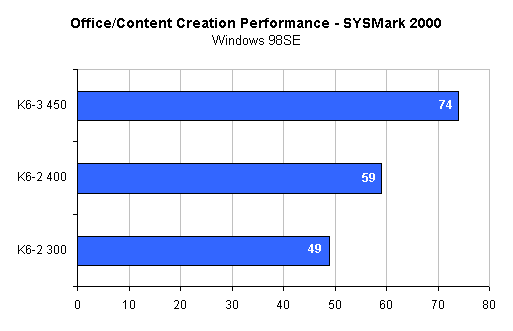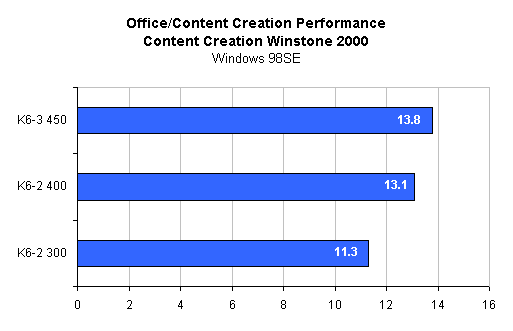CPU Upgrade - Content Creation Performance
Typically one of the more conventional methods of upgrading a computer involves replacing the processor. To many this seems like the only method of upgrade. Although this is not the case, it is important to see what kind of performance is to be expected when upgrading the CPU.
To test the effectiveness of a CPU upgrade, we replaced the 300 MHz K6-2 in our base system with two different CPU's: the K6-2 400 MHz and the K6-3 450 MHz. The speed choices of these processors may seem low, but finding faster K6 series processors takes quite a bit of searching. The K6-2 400 and K6-3 450 should give us a rough estimate of what kind of performance increase to expect when going up by 100 and 150 MHz. Keep in mind that for the following tests, everything in the base system was left the same, with only the processor and processor speed changing.
CPU - SYSMark 2000
SYSMark 2000, a benchmark many of us are familiar with, is a benchmark of 12 common applications run individually. In this case, performance of a system running a single application at a time is measured, for example the speed of doing a process in Word 2000 without any other applications open.
It is clear to see that CPU speed dramatically increases the speed of common Windows applications. The K6-2 400 MHz upgrade shows a 20% increase in speed compared to our base system and the K6-3 450 MHz shines with a 51% increase in performance. Both of these increases in performance are large and without question will be noticed by the user.
Although we were able to get the system to 74 SYSMark points, this is still well below the fastest SYSMark speed we have seen. Take the Athlon 1.2 GHz on an AMD 760 motherboard in Windows 2000 and one can see that the score of 74 does not compare with 245 points this system was able to achieve. It is not possible to work miracles, only to make things somewhat more bearable for a small price.
CPU - Content Creation Winstone 2000Content Creation Winstone 2000 simulates actual computer use more effectively by actually multitasking applications. For example, Word 2000 may be running in the background while Adobe Photoshop is used to edit a picture. Let's see how our base system improves in these situations with a CPU upgrade.

Unlike the 51% increase in performance seen in SYSMark 2000 with a K6-3 upgrade, the K6-3 only shows a 22% increase in performance over the base system. Perhaps most surprising is that the K6-3 450 MHz is only 5% faster than the K6-2 400 MHz. This indicates that a bottleneck besides CPU still exists in our base system. Since a computer is only as fast as its slowest component, something in our system configuration is preventing the K6-3 450 MHz from reaching its maximum potential in 2D multitasking applications.










0 Comments
View All Comments